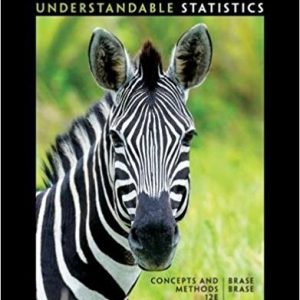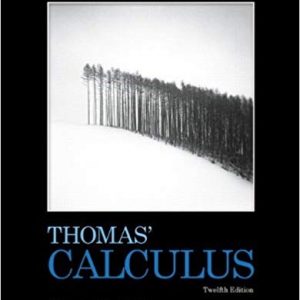This is completed downloadable of Physical Chemistry 2nd Edition Ball Solutions Manual
Product Details:
- ISBN-10 : 1133958435
- ISBN-13 : 978-1133958437
- Author: Ball
With its easy-to-read approach and focus on core topics, PHYSICAL CHEMISTRY, 2e provides a concise, yet thorough examination of calculus-based physical chemistry. The Second Edition, designed as a learning tool for students who want to learn physical chemistry in a functional and relevant way, follows a traditional organization and now features an increased focus on thermochemistry, as well as new problems, new two-column examples, and a dynamic new four-color design. Written by a dedicated chemical educator and researcher, the text also includes a review of calculus applications as applied to physical chemistry.
Table of Content:
- Ch 1: Gases and the Zeroth Law of Thermodynamics
- Introduction
- 1.1: Synopsis
- 1.2: System, Surroundings, and State
- 1.3: The Zeroth Law of Thermodynamics
- 1.4: Equations of State
- 1.5: Partial Derivatives and Gas Laws
- 1.6: Nonideal Gases
- 1.7: More on Derivatives
- 1.8: A Few Partial Derivatives Defined
- 1.9: Thermodynamics at the Molecular Level
- 1.10: Summary
- Key Equations
- Exercises for Chapter 1
- Ch 2: The First Law of Thermodynamics
- Introduction
- 2.1: Synopsis
- 2.2: Work and Heat
- 2.3: Internal Energy and the First Law of Thermodynamics
- 2.4: State Functions
- 2.5: Enthalpy
- 2.6: Changes in State Functions
- 2.7: Joule-Thomson Coefficients
- 2.8: More on Heat Capacities
- 2.9: Phase Changes
- 2.10: Chemical Changes
- 2.11: Changing Temperatures
- 2.12: Biochemical Reactions
- 2.13: Summary
- Key Equations
- Exercises for Chapter 2
- Ch 3: The Second and Third Laws of Thermodynamics
- Introduction
- 3.1: Synopsis
- 3.2: Limits of the First Law
- 3.3: The Carnot Cycle and Efficiency
- 3.4: Entropy and the Second Law of Thermodynamics
- 3.5: More on Entropy
- 3.6: Order and the Third Law of Thermodynamics
- 3.7: Entropies of Chemical Reactions
- 3.8: Summary
- Key Equations
- Exercises for Chapter 3
- Ch 4: Gibbs Energy and Chemical Potential
- Introduction
- 4.1: Synopsis
- 4.2: Spontaneity Conditions
- 4.3: The Gibbs Energy and the Helmholtz Energy
- 4.4: Natural Variable Equations and Partial Derivatives
- 4.5: The Maxwell Relationships
- 4.6: Using Maxwell Relationships
- 4.7: Focus on ∆G
- 4.8: The Chemical Potential and Other Partial Molar Quantities
- 4.9: Fugacity
- 4.10: Summary
- Key Equations
- Exercises for Chapter 4
- Ch 5: Introduction to Chemical Equilibrium
- Introduction
- 5.1: Synopsis
- 5.2: Equilibrium
- 5.3: Chemical Equilibrium
- 5.4: Solutions and Condensed Phases
- 5.5: Changes in Equilibrium Constants
- 5.6: Amino Acid Equilibria
- 5.7: Summary
- Key Equations
- Exercises for Chapter 5
- Ch 6: Equilibria in Single-Component Systems
- Introduction
- 6.1: Synopsis
- 6.2: A Single-Component System
- 6.3: Phase Transitions
- 6.4: The Clapeyron Equation
- 6.5: Gas-Phase Effects
- 6.6: Phase Diagrams and the Phase Rule
- 6.7: Natural Variables and Chemical Potential
- 6.8: Summary
- Key Equations
- Exercises for Chapter 6
- Ch 7: Equilibria in Multiple-Component Systems
- Introduction
- 7.1: Synopsis
- 7.2: The Gibbs Phase Rule
- 7.3: Two Components: Liquid/Liquid Systems
- 7.4: Nonideal Two-Component Liquid Solutions
- 7.5: Liquid/Gas Systems and Henry’s Law
- 7.6: Liquid/Solid Solutions
- 7.7: Solid/Solid Solutions
- 7.8: Colligative Properties
- 7.9: Summary
- Key Equations
- Exercises for Chapter 7
- Ch 8: Electrochemistry and Ionic Solutions
- Introduction
- 8.1: Synopsis
- 8.2: Charges
- 8.3: Energy and Work
- 8.4: Standard Potentials
- 8.5: Nonstandard Potentials and Equilibrium Constants
- 8.6: Ions in Solution
- 8.7: Debye-Hückel Theory of Ionic Solutions
- 8.8: Ionic Transport and Conductance
- 8.9: Summary
- Key Equations
- Exercises for Chapter 8
- Ch 9: Pre-Quantum Mechanics
- Introduction
- 9.1: Synopsis
- 9.2: Laws of Motion
- 9.3: Unexplainable Phenomena
- 9.4: Atomic Spectra
- 9.5: Atomic Structure
- 9.6: The Photoelectric Effect
- 9.7: The Nature of Light
- 9.8: Quantum Theory
- 9.9: Bohr’s Theory of the Hydrogen Atom
- 9.10: The de Broglie Equation
- 9.11: The End of Classical Mechanics
- Key Equations
- Exercises for Chapter 9
- Ch 10: Introduction to Quantum Mechanics
- Introduction
- 10.1 Synopsis
- 10.2 The Wavefunction
- 10.3: Observables and Operators
- 10.4: The Uncertainty Principle
- 10.5: The Born Interpretation of the Wavefunction; Probabilities
- 10.6: Normalization
- 10.7: The Schrödinger Equation
- 10.8: An Analytic Solution: The Particle-in-a-Box
- 10.9: Average Values and Other Properties
- 10.10: Tunneling
- 10.11: The Three-Dimensional Particle-in-a-Box
- 10.12: Degeneracy
- 10.13: Orthogonality
- 10.14: The Time-Dependent Schrödinger Equation
- 10.15: Summary of Postulates
- Key Equations
- Exercises for Chapter 10
- Ch 11: Quantum Mechanics: Model Systems and the Hydrogen Atom
- Introduction
- 11.1: Synopsis
- 11.2: The Classical Harmonic Oscillator
- 11.3: The Quantum-Mechanical Harmonic Oscillator
- 11.4: The Harmonic Oscillator Wavefunctions
- 11.5: The Reduced Mass
- 11.6: Two-Dimensional Rotations
- 11.7: Three-Dimensional Rotations
- 11.8: Other Observables in Rotating Systems
- 11.9: The Hydrogen Atom: A Central Force Problem
- 11.10: The Hydrogen Atom: The Quantum-Mechanical Solution
- 11.11: The Hydrogen Atom Wavefunctions
- 11.12: Summary
- Key Equations
- Exercises for Chapter 11
- Ch 12: Atoms and Molecules
- Introduction
- 12.1: Synopsis
- 12.2: Spin
- 12.3: The Helium Atom
- 12.4: Spin Orbitals and the Pauli Principle
- 12.5: Other Atoms and the Aufbau Principle
- 12.6: Perturbation Theory
- 12.7: Variation Theory
- 12.8: Linear Variation Theory
- 12.9: Comparison of Variation and Perturbation Theories
- 12.10: Simple Molecules and the Born-Oppenheimer Approximation
- 12.11: Introduction to LCAO-MO Theory
- 12.12: Properties of Molecular Orbitals
- 12.13: Molecular Orbitals of Other Diatomic Molecules
- 12.14: Summary
- Key Equations
- Exercises for Chapter 12
- Ch 13: Introduction to Symmetry in Quantum Mechanics
- Introduction
- 13.1: Synopsis
- 13.2: Symmetry Operations and Point Groups
- 13.3: The Mathematical Basis of Groups
- 13.4: Molecules and Symmetry
- 13.5: Character Tables
- 13.6: Wavefunctions and Symmetry
- 13.7: The Great Orthogonality Theorem
- 13.8: Using Symmetry in Integrals
- 13.9: Symmetry-Adapted Linear Combinations
- 13.10: Valence Bond Theory
- 13.11: Hybrid Orbitals
- 13.12: Summary
- Key Equations
- Exercises for Chapter 13
- Ch 14: Rotational and Vibrational Spectroscopy
- Introduction
- 14.1: Synopsis
- 14.2: Selection Rules
- 14.3: The Electromagnetic Spectrum
- 14.4: Rotations in Molecules
- 14.5: Selection Rules for Rotational Spectroscopy
- 14.6: Rotational Spectroscopy
- 14.7: Centrifugal Distortions
- 14.8: Vibrations in Molecules
- 14.9: The Normal Modes of Vibration
- 14.10: Quantum-Mechanical Treatment of Vibrations
- 14.11: Selection Rules for Vibrational Spectroscopy
- 14.12: Vibrational Spectroscopy of Diatomic and Linear Molecules
- 14.13: Symmetry Considerations for Vibrations
- 14.14: Vibrational Spectroscopy of Nonlinear Molecules
- 14.15: Nonallowed and Nonfundamental Vibrational Transitions
- 14.16: Group Frequency Regions
- 14.17: Rotational-Vibrational Spectroscopy
- 14.18: Raman Spectroscopy
- 14.19: Summary
- Key Equations
- Exercises for Chapter 14
- Ch 15: Introduction to Electronic Spectroscopy and Structure
- Introduction
- 15.1: Synopsis
- 15.2: Selection Rules
- 15.3: The Hydrogen Atom
- 15.4: Angular Momenta: Orbital and Spin
- 15.5: Multiple Electrons: Term Symbols and Russell-Saunders Coupling
- 15.6: Electronic Spectra of Diatomic Molecules
- 15.7: Vibrational Structure and the Franck-Condon Principle
- 15.8: Electronic Spectra of Polyatomic Molecules
- 15.9: Electronic Spectra of π Electron Systems: Hückel Approximations
- 15.10: Benzene and Aromaticity
- 15.11: Fluorescence and Phosphorescence
- 15.12: Lasers
- 15.13: Summary
- Key Equations
- Exercises for Chapter 15
- Ch 16: Introduction to Magnetic Spectroscopy
- Introduction
- 16.1: Synopsis
- 16.2: Magnetic Fields, Magnetic Dipoles, and Electric Charges
- 16.3: Zeeman Spectroscopy
- 16.4: Electron Spin Resonance
- 16.5: Nuclear Magnetic Resonance
- 16.6: Summary
- Key Equations
- Exercises for Chapter 16
- Ch 17: Statistical Thermodynamics: Introduction
- Introduction
- 17.1: Synopsis
- 17.2: Some Statistics Necessities
- 17.3: The Ensemble
- 17.4: The Most Probable Distribution: Maxwell-Boltzmann Distribution
- 17.5: Thermodynamic Properties from Statistical Thermodynamics
- 17.6: The Partition Function: Monatomic Gases
- 17.7: State Functions in Terms of Partition Functions
- 17.8: Summary
- Key Equations
- Exercises for Chapter 17
- Ch 18: More Statistical Thermodynamics
- Introduction
- 18.1: Synopsis
- 18.2: Separating q: Nuclear and Electronic Partition Functions
- 18.3: Molecules: Electronic Partition Functions
- 18.4: Molecules: Vibrations
- 18.5: Diatomic Molecules: Rotations
- 18.6: Polyatomic Molecules: Rotations
- 18.7: The Partition Function of a System
- 18.8: Thermodynamic Properties of Molecules from Q
- 18.9: Equilibria
- 18.10: Crystals
- 18.11: Summary
- Key Equations
- Exercises for Chapter 18
- Ch 19: The Kinetic Theory of Gases
- Introduction
- 19.1: Synopsis
- 19.2: Postulates and Pressure
- 19.3: Definitions and Distributions of Velocities of Gas Particles
- 19.4: Collisions of Gas Particles
- 19.5: Effusion and Diffusion
- 19.6: Summary
- Key Equations
- Exercises for Chapter 19
- Ch 20: Kinetics
- Introduction
- 20.1: Synopsis
- 20.2: Rates and Rate Laws
- 20.3: Characteristics of Specific Initial Rate Laws
- 20.4: Equilibrium for a Simple Reaction
- 20.5: Parallel and Consecutive Reactions
- 20.6: Temperature Dependence
- 20.7: Mechanisms and Elementary Processes
- 20.8: The Steady-State Approximation
- 20.9: Chain and Oscillating Reactions
- 20.10: Transition-State Theory
- 20.11: Summary
- Key Equations
- Exercises for Chapter 20
- Ch 21: The Solid State: Crystals
- Introduction
- 21.1: Synopsis
- 21.2: Types of Solids
- 21.3: Crystals and Unit Cells
- 21.4: Densities
- 21.5: Determination of Crystal Structures
- 21.6: Miller Indices
- 21.7: Rationalizing Unit Cells
- 21.8: Lattice Energies of Ionic Crystals
- 21.9: Crystal Defects and Semiconductors
- 21.10: Summary
- Key Equations
- Exercises for Chapter 21
- Ch 22: Surfaces
- Introduction
- 22.1: Synopsis
- 22.2: Liquids: Surface Tension
- 22.3: Interface Effects
- 22.4: Surface Films
- 22.5: Solid Surfaces
- 22.6: Coverage and Catalysis
- 22.7: Summary
- Key Equations
- Exercises for Chapter 22
- Appendixes
- Appendix 1: Useful Integrals
- Appendix 2: Thermodynamic Properties of Various Substances
- Appendix 3: Character Tables
- Appendix 4: Infrared Correlation Tables
- Appendix 5: Nuclear Properties
- Answers to Selected Exercises
- Index
People Also Search:
atkins physical chemistry 2nd edition
physical chemistry 2nd edition year
physical chemistry mcquarrie 2nd edition





